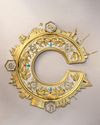
FACE OFF
For all their similarities, Viture One and Nreal Air aren't quite identical. The Viture pair have a touch more style about them (though in truth, neither looks quite like something you could convincingly wear to the beach) and a magnetic connector, rather than Nreal's USB-C port, making it easier to connect or disconnect once the glasses are on your face. Perhaps the biggest difference, though, is how they handle unwanted light: One's electrochromic film can be dimmed at the push of a button, while Air has a plastic 'light shield' that you can snap onto their front, leaving you looking a little like you're recovering from eye surgery.
Ten years have passed since Google co-founder Sergey Brin took to the stage during the keynote of the company's I/O event to give the world its first real demo of Google Glass. It was a defining moment in the public understanding of smart glasses, albeit perhaps not in the way Brin might have hoped, as the tech became something of a byword for misconceived tech projects. But in this year's keynote - just in time for the decaversary - Google CEO Sundar Pichai introduced a similar demo of the company's next smart glass project. "Subtitles for the world", was the description that stuck, providing live captioning of speech for the benefit of the deaf or hard of hearing, or for people speaking different languages. The focus, then, was on something Glass infamously lacked: a clear reason to exist.
Denne historien er fra August 2022-utgaven av Edge UK.
Start din 7-dagers gratis prøveperiode på Magzter GOLD for å få tilgang til tusenvis av utvalgte premiumhistorier og 9000+ magasiner og aviser.
Allerede abonnent ? Logg på
Denne historien er fra August 2022-utgaven av Edge UK.
Start din 7-dagers gratis prøveperiode på Magzter GOLD for å få tilgang til tusenvis av utvalgte premiumhistorier og 9000+ magasiner og aviser.
Allerede abonnent? Logg på

BONAPARTE: A MECHANIZED REVOLUTION
No sooner have we stepped into the boots of royal guard Bonaparte than we’re faced with a life-altering decision.

TOWERS OF AGHASBA
Watch Towers Of Aghasba in action and it feels vast. Given your activities range from deepwater dives to climbing up cliffs or lumbering beasts, and from nurturing plants or building settlements to pinging arrows at the undead, it’s hard to get a bead on the game’s limits.

THE STONE OF MADNESS
The makers of Blasphemous return to religion and insanity

Vampire Survivors
As Vampire Survivors expanded through early access and then its two first DLCs, it gained arenas, characters and weapons, but the formula remained unchanged.

Devil May Cry
The Resident Evil 4 that never was, and the Soulslike precursor we never saw coming

Dragon Age: The Veilguard
With Dragon Age: The Veilguard, BioWare has made a deeply self-conscious game, visibly inspired by some of the best-loved ideas from Dragon Age and Mass Effect.

SKATE STORY
Hades is a halfpipe

SID MEIER'S CIVILIZATION VII
Firaxis rethinks who makes history, and how it unfolds

FINAL FANTASY VII: REBIRTH
Remaking an iconic game was daunting enough then the developers faced the difficult second entry

THUNDER LOTUS
How Spirit farer's developer tripled in size without tearing itself apart